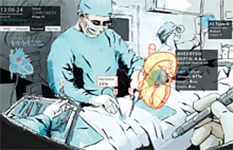UMD Receives NSF Major Research Instrumentation Award in Support of Virtual and Augmented Reality
UMD Receives NSF Major Research Instrumentation Award in Support of Virtual and Augmented Reality

Visualization tools that allow a surgeon to “see through” a patient during surgery. Wearable sensors that encourage healthier behavior. Virtual-based headsets that train soldiers how to remove a wounded comrade from the battlefield.
Innovations like these and more under development at the University of Maryland just got a big boost.
The National Science Foundation (NSF) has awarded UMD a $600,000 Major Research Instrumentation grant in support of virtual and augmented reality research and education. Virtual reality (VR) either mimics real-world settings or creates fantasy worlds; augmented reality (AR) embeds digital information into real-world settings.
Both fields are expected to expand exponentially in the near future in applications tied to scientific visualization, entertainment, military uses, architecture, navigation, education, prototyping, collaborative communication, and more.
The NSF grant will be used to purchase new equipment and provide infrastructure support for a 1,000-square-foot “augmentarium” now under construction. The Virtual and Augmented Reality Laboratory will feature interactive projection displays, robotic mounts and high-speed computing clusters that, university officials say, will position UMD as a leader for the effective visualization of large and complex data.
When launched later this year, the interactive lab will bring together researchers from across campus and beyond to explore ideas and technologies that combine real-time data within virtual settings and backdrops.
“These technologies will engage our faculty and students to explore new pathways of discovery that can have far-reaching scientific and societal benefits,” says Jayanth Banavar(link is external), dean of the College of Computer, Mathematical, and Natural Sciences(link is external) (CMNS).
The virtual and augmented reality lab is the latest addition to the university’s Institute for Advanced Computer Studies (UMIACS), with its director, Amitabh Varshney, named as principal investigator of the NSF award.
Projects supported by the grant include: understanding large-scale astronomy data (Lee Mundy(link is external) in astronomy); weather and climate prediction (Kayo Ide(link is external) in atmospheric and oceanic science); characterization of stem cells (Peter Bajcsy(link is external) at the National Institute of Standards and Technology and Antonio Cardone in UMIACS); large-scale simulation of rotorcraft brownouts via accelerated algorithms (Ramani Duraiswami in computer science and UMIACS); data visualization for cybersecurity (Tudor Dumitras in electrical and computer engineering and UMIACS); user interaction with augmented reality (Catherine Plaisant in UMIACS and Rama Chellappa in electrical and computer engineering and UMIACS); visualization of big data (Joseph JaJa in electrical and computer engineering and UMIACS, and Varshney); and augmented reality-based, image-guided surgical interventions (Rao Gullapalli(link is external) in radiology at the University of Maryland, Baltimore, and Varshney).
The NSF grant also provides for education and training, with plans for the Maryland Center for Women in Computing(link is external) to develop workshops that encourage middle school and high school girls to participate in VR and AR projects.
Other research will study how people interact with VR and AR technologies, and how they can best be used in an educational setting.
The virtual and augmented reality lab will also take advantage of several cross-institutional partnerships supported by MPowering the State(link is external), which joins scientists at the University of Maryland with physicians, clinicians and other health experts at the University of Maryland, Baltimore.
“We look forward to further collaboration with our colleagues in Baltimore to identify opportunities and leverage our combined strengths in computing power and clinical expertise,” says Varshney.
Researchers from both institutions envision specialized headgear that surgeons can wear in an operating room, providing real-time patient and surgical data that is “overlaid” on top of a patient during surgery.
Additional projects will look at wearable sensors that can track the movement of people suffering from neurological disorders like Parkinson’s disease, keeping tabs on the disease’s progression in hopes of providing better therapeutic outcomes. Also under discussion are wearable technologies that monitor human activity and offer visual feedback via warnings or positive responses, both of which can promote healthier behavior.
The federal government is very interested in VR and AR applications, including the development of specialized headwear that can provide soldiers with critical information like weather, combat efficiency, and the location of both friendly and adversarial forces. Other applications can train soldiers in essential tasks, such as evacuating wounded comrades while under fire on a virtual battlefield.
Initial seed funding for the UMD virtual and augmented reality lab came from CMNS, with additional support from the university’s Division of Research and the provost’s office.
To view illustrations of several virtual and augmented reality projects under development at UMD, go here.
Related Articles:UMD Wins $5M Phase 2 NSF Convergence Accelerator Award
UMD Researchers Creating First Onboard Fast-Charging System for Electric Vehicles
NSF Funds Novel Research to Create Scalable Wireless Networking, Averting Usage Crisis
Dachman-Soled Wins NSF Career Award
UMD Researchers Use Artificially Engineered Materials to Create Breakthrough for Sound Sensors
Li and Hu Awarded NSF Grant to Study Challenges in Creating Materials that are Both Stronger and Tougher
UMD Welcomes Johns Hopkins to DC Innovation Corps
MC2 Director Katz Testifies Before Senate Subcommittee on Investing in Cybersecurity
Vishkin Offers Fresh Perspective on Commodity Computing in ACM Viewpoint
UMD, Xerox Seek to Improve Mobile Document Scanning
September 9, 2014
Prev Next
Connect
Did You Know

UMD is the only major public research university inside the Washington, DC beltway!!
